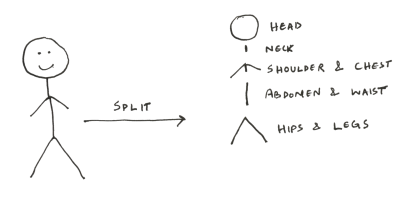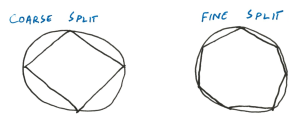If you belong to any discipline which involves research using computers and simulations, chances are that you have used the Finite Element Method (FEM) already.
The purpose of this article is to explain FEM as simple as possible. This suits both of us, because I personally am not very well versed with the mathematical formulations that act as the bases of FEM. Lets see an example to understand FEM then.
Let’s assume you know someone named Mr. Müller (It has to be Mr. Müller if you are in Germany) . Now assume you are sitting in a Biergarten and observing Mr. Müller frying the sausages ( what else ! ), Mr. Müller gets into a fight and gets punched in his face.
Now lets just put aside our feelings of empathy for a few seconds and think about the impact of the punch on his body from a purely mechanical point of view. From personal experience ( I mean common sense, not experience of getting punched) you would guess that different parts of body would resist, the resulting moment due to punch around your feet, differently.
If you were to solve this exactly then theoretically you would need to consider the mechanical behavior of each cell (or atom or molecule) in your body, this is because each cell in your body provides different resistance to the impact force. This means you require a partial differential equation in which each cell is an independent variable- equation with infinite variables !
Obviously, constructing such an equation is impossible, let alone solving it. So you need to simplify the problem, and need to do it as fast as possible because Mr. Müller is lying in the deformed state (punched state) all the while we try to understand fem. What you can do is split Mr. Müllers body (not literally of course) into different regions/parts that you believe show similar mechanical behavior. This means that you can assume that the behavior of the cells which make up the head can be statistically averaged to exhibit an almost unique combined/cumulative resistance to force. Similar simplifications can be applied to the cells that make up the neck, back, hips and legs etc.
Now that you have split Mr. Müller’s body into different regions with similar mechanical behavior, you can write an equation (even an algebraic equation i.e. not partial differential) that models the mechanical behavior of different parts of the body and also how they interact with each other (coupling between the parts). Coupling here means how Mr. Müllers face transfers the force to his neck, then his neck to his chest and so on till the point of contact with the ground.
You can assume that the head offers kx units of resistance, where k is the stiffness of the head and x is the distance by which head rotates). Similarly the neck offers k2x2 amount of resistance and different other parts offer resistance depending upon their shape and mass.
If you model the behavior of the body like this the resulting equation will be algebraic (not a partial differential equation) and it is much easier to solve an algebraic equation than a differential equation.
This method of splitting a body into smaller parts, assuming simple behavior of those parts and then solving the resulting algebraic equations is in a nutshell finite element analysis. you can replace Mr. Müller with a car and the punch with wind load, or with a motor and electrical loads, the basic technique remains the same- divide the original problem into smaller problems and assume approximate behavior in those problems.
The reason you divide the body into smaller parts is that you are using approximate behavior to model the original behavior, which obviously results in some error, so the accuracy of the approximation increases with the number of divisions of the body. You can understand this concept by trying to calculate the circumference of a circle without using the formula.
It should be clear that the more finely you split the circle, the more closer your estimate gets to the analytical solution (π*dia of circle)
I will close my discussion of fem here and relieve Mr. Müller of his pain. If I can think of some simple explanation of how “Principle of Virtual Work” and “Principle of Minimum Potential Energy” are used to define the basic formulation of the finite element method then I will add in this article. You can also check out the tutorial section for further information relevant to fem.






Very nice example !
LikeLike
Mr. Müller will come back and get you. Keep it up Adele :]
LikeLike
In that case, I will discretize him again. With much more painful partitions this time 🙂
LikeLike
Nice 😀
LikeLike
Lovely blog!
I’m quite interested to see your comparison of Abaqus and LS-Dyna as well.
Keep it up.
LikeLiked by 1 person
Thanks 🙂
LikeLike
Nice man. What about the punch itself and the force it exerts? : )
LikeLike
Nice, We are excited about your wonderful articles, and waiting forward to the “comparison of Abaqus and LS-Dyna” article.
LikeLike